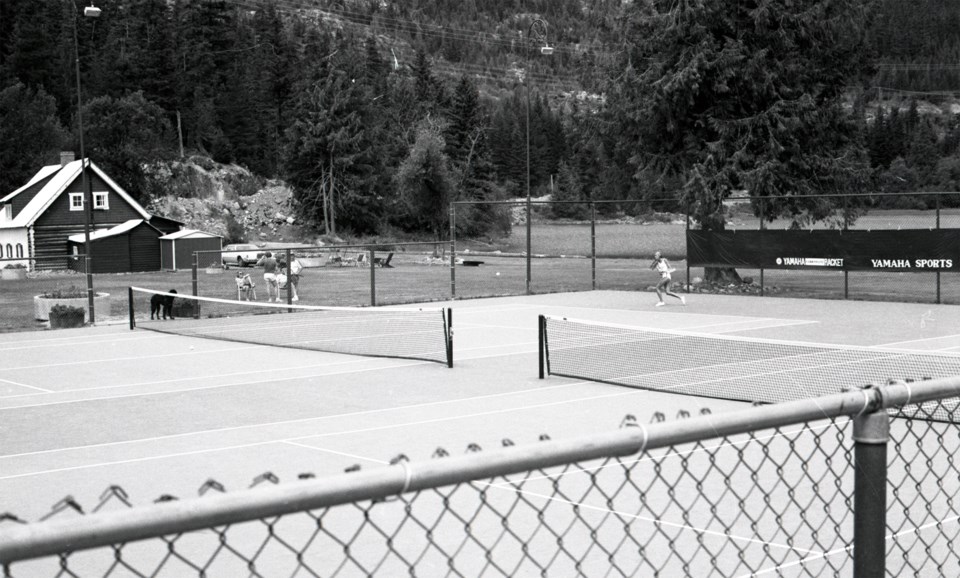In the late 1960s, when Al and Nancy Raine first bought property in White Gold, there had been talk about building tennis courts in the Whistler area for many years—but none had yet materialized. Wanting to play tennis, the Raines (who had purchased two lots) built a clay court next door to their house. According to a 2018 interview with Al, as the owners of the only tennis court in the valley, he and Nancy soon found they “had more friends for some reason.” In the spring, summer and fall months, friends (and maybe some acquaintances) would frequently come over for a game.
A few years later, John Taylor, then the owner of more than 65 hectares in today’s Creekside area, built tennis courts at Jordan’s Lodge on Nita Lake. These courts were used by residents, visitors, and even campers from the Toni Sailer Summer Ski Camp. When Myrtle Philip School opened in 1976, four tennis courts were built next to it, the first asphalt courts in the valley. Clearly, the appetite for tennis in the valley was growing.
In 1978, Michael d’Artois remembers getting together with other tennis players at JB’s and forming the Whistler Valley Tennis Club. Using the courts at Nita Lake, they began hosting lessons and tournaments, including the first tournament of the 1978 season over the May long weekend. The tennis tournament (part of larger celebrations that weekend that included the Great Snow Earth Water Race and a belly flop competition) cost $3.50 to enter and, according to the Whistler Question, the winner got to keep the balls used and was presented with a “Whistler original perpetual trophy.” Over the following years, the club would continue to host a tournament over the May long weekend, as well as other events throughout the season.
According to stories from members of the club, players were competitive (some more than others), but also friendly and social. Al remembered the deck of JB’s (today Roland’s Pub and the Red Door Bistro) was located alongside the courts, which meant people could sit on the deck to have a drink and watch the tennis games below. According to Al, this was “actually pretty ideal.” In order to play a game, you didn’t necessarily have to organize with a partner ahead of time; instead, a member of the club could go over to JB’s, go out on the deck, see who was playing and who was around, and pick a partner.
Tennis grew throughout the 1980s, and over time Taylor (also a member of the club) added an additional two courts and a small building that could be used by the club (he also added a fifth covered court in the 1990s). Club membership grew, and the Whistler Valley Tennis Club became officially recognized as a non-profit society. Members paid dues, a pro was hired, and volunteers maintained the courts (some years the Whistler Fire Department would help out by washing the asphalt).
Esther Gorman moved to Whistler full-time in 1985 and joined the club in the summer of 1987. Looking back in 2018, she recalled the club was where she met most of her “lifetime friends.” (She also remembered playing in a mixed doubles tournament with Taylor and that, after they won, he named one of the courts after her.) Her husband, John Koenig, echoed her feelings. He joined in 1992, when the club had 250 adult members and a waitlist, and made many close friendships through tennis, as well as meeting Esther.
Through the 1990s, after the new tennis facility opened next to Whistler Village, members began to move to the new tennis club, though some maintained memberships in both. In the 2000s, Nita Lake Lodge was built on the site of Jordan’s Lodge and Taylor’s tennis courts, and today a house sits atop the Raines’ clay court. Though it eventually stopped hosting tournaments or organizing lessons and camps, the Whistler Valley Tennis Club maintained its non-profit status for many years in order to act as an advocate for the sport in Whistler. Today, tennis and other racket sports continue to be competitive and social (and often both) pastimes in the valley.




